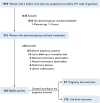A predictive model of pregnancy loss using pre-pregnancy endocrine and immunological parameters in women with abnormal glucose/lipid metabolism and previous pregnancy loss
- PMID: 38898223
- PMCID: PMC11445311
- DOI: 10.1007/s12020-024-03937-7
A predictive model of pregnancy loss using pre-pregnancy endocrine and immunological parameters in women with abnormal glucose/lipid metabolism and previous pregnancy loss
Abstract
Objective: To investigate the clinical and endocrine risk factors for pregnancy loss in women with abnormal glucose/lipid metabolism and a history of pregnancy loss, and to develop a predictive model to assess the risk of pregnancy loss in these women's subsequent pregnancies.
Methods: Patients with a history of pregnancy loss who had abnormal glucose/lipid metabolism were retrospectively included in this study, and their pre-pregnancy baseline and clinical characteristics were collected. A predictive nomogram was constructed based on the results of the multivariable logistic regression model analysis, and its calibration and discriminatory capabilities were evaluated. The internal validation was then performed and the net benefits were assessed by the clinical decision curve.
Results: The predictive model was eventually incorporated eight variables, including maternal age, previous pregnancy losses, anticardiolipin antibody (aCL) IgG, aCL IgM, thyroid peroxidase antibody, complement 4, free thyroxine and total cholesterol. The area under the curve (AUC) of the nomogram was 0.709, and Chi-square value and P value of the Hosmer-Lemeshow test were 12.786 and 0.119, respectively, indicating that the nomogram had a satisfactory calibration and discriminatory performance. The validation cohort showed a similar result for the discrimination of the nomogram (AUC = 0.715). The clinical decision curve demonstrated the nomogram had good positive net benefits.
Conclusions: This is the first study to predict the risks of subsequent pregnancy loss in women with abnormal glucose/lipid metabolism and history of pregnancy loss using pre-pregnancy clinical and endocrine parameters. This predictive nomogram may provide clinicians assistance to personalize the management of subsequent pregnancies in these patients.
Keywords: Abnormal glucose/lipid metabolism; Nomogram; Pre-pregnancy endocrine parameters; Predictive model; Previous pregnancy loss.
© 2024. The Author(s).
Conflict of interest statement
The authors declare no competing interests.
Figures




Similar articles
-
Constructing a logistic regression-based prediction model for subsequent early pregnancy loss in women with pregnancy loss.Eur J Med Res. 2025 Feb 12;30(1):99. doi: 10.1186/s40001-025-02361-5. Eur J Med Res. 2025. PMID: 39940054 Free PMC article.
-
A nomogram and risk stratification to predict subsequent pregnancy loss in patients with recurrent pregnancy loss.Hum Reprod. 2024 Oct 1;39(10):2221-2232. doi: 10.1093/humrep/deae181. Hum Reprod. 2024. PMID: 39178353
-
A new prognostic model for recurrent pregnancy loss: assessment of thyroid and thromboelastograph parameters.Front Endocrinol (Lausanne). 2024 May 30;15:1415786. doi: 10.3389/fendo.2024.1415786. eCollection 2024. Front Endocrinol (Lausanne). 2024. PMID: 38883610 Free PMC article.
-
A nomogram based on hematological parameters for prediction of spontaneous abortion risk in pregnancies.BMC Pregnancy Childbirth. 2025 Mar 11;25(1):271. doi: 10.1186/s12884-025-07396-4. BMC Pregnancy Childbirth. 2025. PMID: 40069650 Free PMC article.
-
A Novel Nomogram for Predicting the Risk of Premature Delivery Based on the Thyroid Function in Pregnant Women.Front Endocrinol (Lausanne). 2022 Jan 10;12:793650. doi: 10.3389/fendo.2021.793650. eCollection 2021. Front Endocrinol (Lausanne). 2022. PMID: 35082756 Free PMC article.
References
-
- R. Rai, L. Regan, Recurrent miscarriage. Lancet 368, 601–611 (2006) - PubMed
-
- D.M. Green, K. O’Donoghue, A review of reproductive outcomes of women with two consecutive miscarriages and no living child. J. Obstet. Gynaecol. 39, 816–821 (2019) - PubMed
-
- M. Tong, T. Kayani, D.M. Jones, J.E. Salmon, S. Whirledge et al. Antiphospholipid antibodies increase endometrial stromal cell decidualization, senescence, and inflammation via toll-like receptor 4, reactive oxygen species, and p38 MAPK signaling. Arthritis Rheumatol. 74, 1001–1012 (2022) - PMC - PubMed
-
- R. Vissenberg, V.D. Manders, S. Mastenbroek, E. Fliers, G.B. Afink et al. Pathophysiological aspects of thyroid hormone disorders/thyroid peroxidase autoantibodies and reproduction. Hum. Reprod. Update 21, 378–387 (2015) - PubMed
MeSH terms
Substances
Grants and funding
LinkOut - more resources
Full Text Sources
Medical

